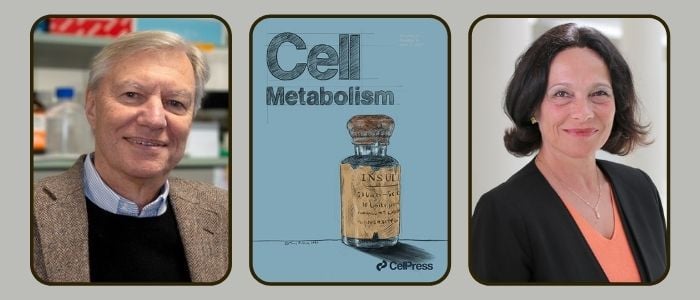UMass Diabetes Center of Excellence Researchers Recognized in Cell Metabolism's 100 Years of Insulin Issue
Michael Czech, PhD and Silvia Corvera, MD reflect on the privilege of studying insulin
Date Posted: Friday, April 16, 2021
2021 marks the 100th anniversary of the first life-saving treatment for diabetes. On July 27, 1921, Dr. Frederick Banting and medical student Charles Best successfully isolated the insulin hormone for the very first time at the University of Toronto. Their breakthrough transformed diabetes treatment forever. Banting & Best: Discovery of Insulin
The April 2021 issue of the scientific journal Cell Metabolism includes stories of scientists and clinicians whose research has advanced our understanding of insulin, islet biology and diabetes.
Two researchers from UMass Chan Medical School’s Diabetes Center of Excellence and Program in Molecular Medicine, Michael P. Czech, PhD and Silvia Corvera, MD are among those who were featured:
The Privilege of Studying Insulin
Research on insulin and its actions was at fever pitch during the years 1975 to 1985. This period spanned the gap from being limited to measuring insulin binding to its mysterious membrane receptor and its cDNA cloning. During this frenzied period on a bright afternoon in 1978, Paul Pilch in the Czech lab at Brown University held up an autoradiograph from his experiment, designed to identify the insulin receptor by affinity crosslinking. Our elation skyrocketed as a remarkable single dark band revealed itself against a totally clear background. Over the next 2 years, Joan Massague with Paul and others in our group used the technique to correctly deduce the insulin receptor’s heterotetrameric subunit configuration and demonstrate a similar structure for the IGF1 receptor. We denoted the two receptor subunits as a and b in PNAS in 1980, which has held up nicely. This exhilarating run of exciting discovery still brings a smile to all involved those 40 years ago. What a privilege to be a scientist!
Despite many such successes in hundreds of labs, the need to translate basic discoveries to the diabetes clinic has never been more urgent. Combining powerful technologies in this effort is now our aim. We are marrying the Corvera lab’s technology to generate large numbers of human adipose tissue stem cells to the Czech lab’s CRISPR-based methods to further enhance their therapeutic potential. Might metabolic diseases be treatable by cell therapies? In humanized mice, we recently found implanting such CRISPR-enhanced ‘‘supercharged’’ human adipocytes lowers blood glucose more than unmodified adipocytes. Indeed, still a privilege to be a scientist!
View the full article in Cell Metabolism titled “Voices: Insulin & Beyond”
Related Stories:
The Corvera Lab is Examining How Different Body Fat Plays a Role in Type 2 Diabetes
